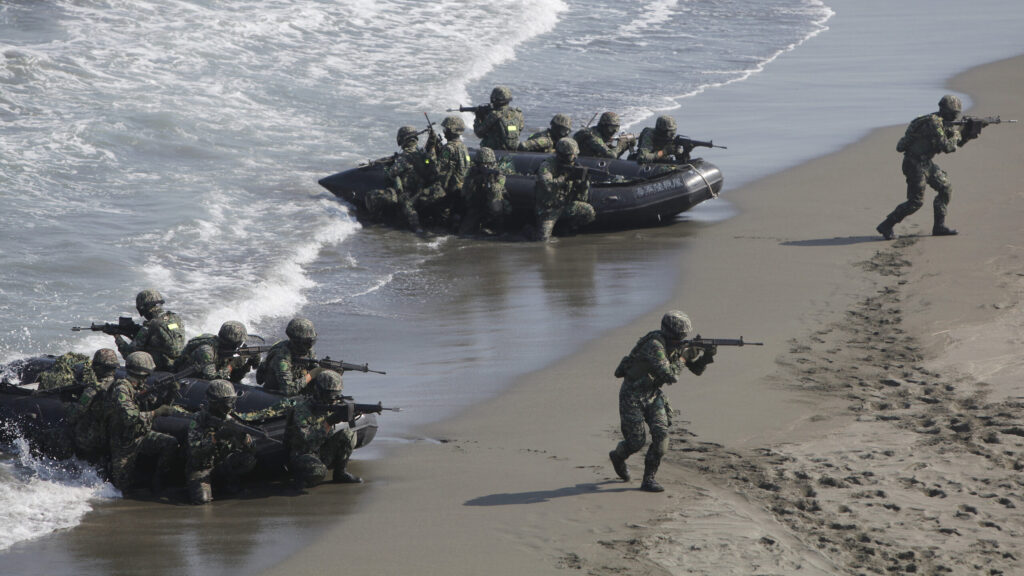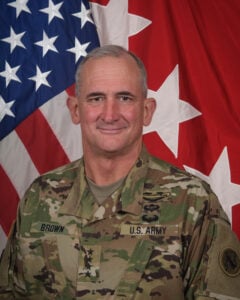
Taiwanese Marines on exercises in 2013 (Photo by Ashley Pon/Getty Images)
Ukraine has riveted attention to ground combat in Europe — but what about a land war in Asia? In this op-ed, former USARPAC commander Gen. Bob Brown, now retired, argues that deterring or defeating a Chinese military landing on Taiwan requires the US Army to be as modernized as its air, naval, space and cyber counterparts.
For years, defense budgets have been influenced by questionable predictions that future warfare would occur primarily in the air, sea, and cyberspace, fought with electrons and missiles, while ground forces play a modest supporting role in long-range fires, force protection, and logistics. But Russia’s war in Ukraine is the latest evidence that these predictions have been wrong.

Gen. Robert Brown during his Army service
No single warfighting domain will dominate in future conflict – even in the watery vastness of the Indo-Pacific. As commander of US Army Pacific from 2016 to 2019, overseeing extensive experimentation and exercises for future Multi-Domain Operations, I saw firsthand that victory will mean converging the unique capabilities of each service to overmatch adversaries in ways that no service could achieve alone.
But inadequate Army funding and end strength are placing this necessary jointness at risk. Between FY2019 and FY2023, as a recent Association of the US Army study lays out, the Army has lost almost $40 billion in buying power through flat or declining budgets, while the other services have roughly broken even or experienced slight increases. What’s more, approximately 80 percent of the Army’s annual budget supports operations — often support operations that only the Army can provide the whole joint force, like logistics, communications, and medical support — leaving less money for modernization than the other services.
The Army has always been an essential member of the joint team in the Pacific, starting from the Philippine Insurrection in 1899. Since Dec. 7, 1941, there have been three major wars in the Pacific — World War II, Korea, and Vietnam. Land warfare has been predominant in all three, and there is no reason to expect this to change.
Some suggest that air and naval forces dominate the Indo-Pacific, and that a war over Taiwan would be fought almost exclusively in these domains. But the rapid growth in China’s military capabilities allows the PLA to deny US air and naval forces from penetrating Chinese defenses if the Navy and Air Force are not supported by agile, survivable Army formations like the Multi-Domain Task Forces (MDTFs). Prevailing in conflict with China requires the US military to present Beijing with multiple dilemmas across every warfighting domain.
Russia’s land war in Ukraine should force us to acknowledge the limitations of our ability to predict the future. Beijing’s political aims may require China to occupy Taiwan with its ground forces to establish permanent control – control that a naval blockade or missile barrage would not guarantee. Several wargames have shown that the United States faces severe obstacles in preventing a Chinese landing on Taiwan, not only military ones, but also legal and political barriers to approving attacks on a nuclear state before an invasion begins and without an existing Authorization for Use of Military Force. In addition to cross-domain capabilities like the MDTFs, the Army may be required to liberate conquered Taiwanese territory after a People’s Liberation Army landing. Underfunding Army modernization may leave the US joint force without the capabilities to do so.
Under-resourcing Army capabilities for large-scale ground combat endangers US interests not only in a Taiwan conflict but also in the broader Indo-Pacific, Europe, and the Middle East. With 28% of the military’s service department budget and less than 50% of the total force, the Army accounts for about two-thirds of global US Combatant Commander requirements. An inadequately resourced Army will also leave Americans less secure at home, as the Army has provided over 80% of the forces necessary to respond rapidly to recent domestic crises, whether administering COVID-19 vaccines to the American public or responding to natural disasters.
Russia’s brutal war in Ukraine demonstrates the devastating costs of conflict when democratic nations fail to deter invasion. The Army’s budget must receive the 3-5% real annual growth necessary to secure America’s national defense, matched by investments in the other services. The United States can still maintain the world’s most formidable military force, but the window to correct our course is rapidly shrinking. Congress’ duty to the American people is to fund an Army so strong that no adversary seeks to fight it and that can win if they try.
Retired Gen. Bob Brown is the president and CEO of the Association of the US Army.






















